OR/16/030 Changes for compass users in Great Britain: Difference between revisions
m 1 revision imported |
No edit summary |
||
| Line 1: | Line 1: | ||
__NOTOC__ | __NOTOC__ | ||
{{OR/16/030}} | {{OR/16/030}} | ||
[[Image: | [[Image:OR16030_stations.jpg|thumb|left|300px| The locations of British repeat stations (spots) and observatories (labelled squares).]] | ||
[[Image: | [[Image:OR16030_northsicon.jpg|thumb|right|300px| The new ‘norths’ icon, produced by the Ordnance Survey.]] | ||
[[Image: | [[Image:OR16030_tonyswan.jpg|thumb|right|300px| Magnetic field observations by Tony Swan made at Godrevy Point in Cornwall in 2015.]] | ||
[[Image: | [[Image:OR16030_grid.jpg|thumb|right|300px| Grid magnetic angle and its annual rate of change in 2015. The shaded area shows where magnetic north is east of grid north.]] | ||
[[Image: | [[Image:OR16030_instrumentation.jpg|thumb|left|300px| Repeat station instrumentation.]] | ||
[[Image: | [[Image:OR16030_greenwich.jpg|thumb|left|300px| Declination over 1550–2010 reduced to the location of the Greenwich observatory.]] | ||
In 2015 measurements of the Earth’s magnetic field were made in Great Britain that indicated the start of a period of easterly Grid Magnetic Angle (GMA) in the country. The last time GMA was easterly was over 350 years ago. | In 2015 measurements of the Earth’s magnetic field were made in Great Britain that indicated the start of a period of easterly Grid Magnetic Angle (GMA) in the country. The last time GMA was easterly was over 350 years ago. | ||
| Line 23: | Line 23: | ||
===Making history=== | ===Making history=== | ||
Before 1660 easterly magnetic angles were recorded by several observers in and around London. But since then we have had varying westerly grid magnetic angles, with the maximum being about 27° west in Shetland in 1818. | Before 1660 easterly magnetic angles were recorded by several observers in and around London. But since then we have had varying westerly grid magnetic angles, with the maximum being about 27° west in Shetland in 1818. | ||
===Grid magnetic angle in 2015=== | ===Grid magnetic angle in 2015=== | ||
Latest revision as of 13:05, 8 July 2016
| Thomson, Alan W P. 2016. Geomagnetism review 2015. British Geological Survey Internal Report, OR/16/030. |
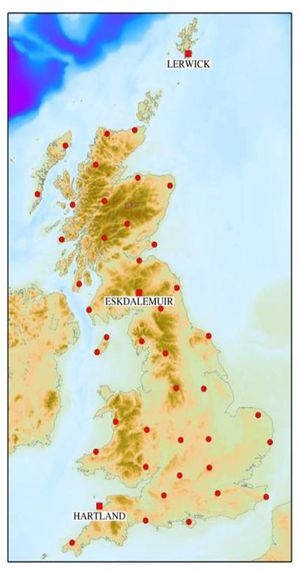
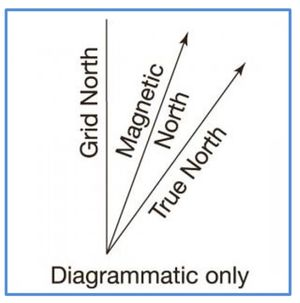
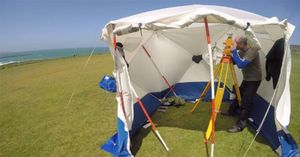
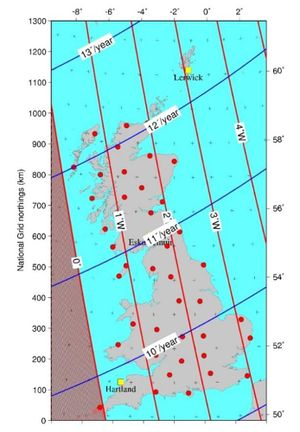

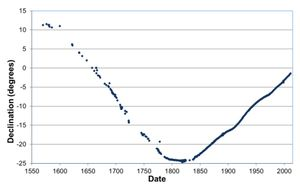
In 2015 measurements of the Earth’s magnetic field were made in Great Britain that indicated the start of a period of easterly Grid Magnetic Angle (GMA) in the country. The last time GMA was easterly was over 350 years ago.
The measurements
Every year observations of the Earth’s magnetic field are made at around ten of the 41 repeat stations spread throughout Great Britain. These data supplement the data from the three magnetic observatories and provide the necessary coverage for production of a regional model of the magnetic field.
The magnetic measurements are made with similar equipment as used to make absolute observations at an observatory, i.e. a non-magnetic fluxgate theodolite and a proton precession magnetometer (PPM). To obtain true azimuth, use is made of two geodetic-quality GPS receivers. A gyro attachment is used as a back-up and for sites with tree coverage affecting GPS.
Each repeat station site was chosen to be free of interference from artificial magnetic field sources such as railway lines, underground utilities and other man-made constructions.
To ensure the permanence of the repeat stations and the network, sites are located in conservation areas and on agricultural land which are unlikely to be developed in the future. Care is taken to make an exact reoccupation of the site so that the slow secular change in the magnetic field can be tracked without any contamination from the local short-wavelength crustal field. Before observations are made the local magnetic field around each site is checked using the PPM. Observations of declination, inclination and total intensity are made. The data are then reduced to quiet night-time values by means of data from the closest observatories.
In 2015 the most south-westerly repeat station was visited again. Once the D observations had been processed and corrected for the angle between true and Ordnance Survey grid north, the resulting grid magnetic angle was found to be easterly.
Making history
Before 1660 easterly magnetic angles were recorded by several observers in and around London. But since then we have had varying westerly grid magnetic angles, with the maximum being about 27° west in Shetland in 1818.
Grid magnetic angle in 2015
Every year the regional model is updated to include the observations from the previous year in order to maintain accuracy. This model is used to provide the Ordnance Survey with the corrections necessary for each of their map products for converting between magnetic bearings and grid bearings. It is also used for the BGS online grid magnetic angle calculator.
It will take over 20 years for magnetic north to become east of grid north everywhere. Also, it will not be until about 2018 that we will see magnetic north east of true north, starting in Kent, working westward in time.